Impact of Global Warming in Subtropical Climate Buildings: Future Trends and Mitigation Strategies
Abstract
1. Introduction
2. Materials and Methods
2.1. Methodology
2.1.1. Acquisition of Historical Climate Data
2.1.2. Acquisition of Present and Future Climate Data
2.1.3. Production of Climate and Consumption Data in the Near Future
2.1.4. Case Study
- Sun shading to prevent heat build-up from direct sunlight entering the building.
- The maximum thermal transmittance of the outer envelope (combining opaque walls and openings), was set at Ue = 0.3 W/m2K.
- The airtightness was defined through an excellent crack template to limit the uncontrolled infiltration airflow (equivalent to a n50 value < 0.6 h−1 EN 13829).
- The current range of indoor temperatures (20–24 °C) that are comfortable for users in Malaga, was calculated using the Humphreys and Nicol [56] statistical model of adaptive comfort, with less than a 10% of discomfort hours.
- The ventilation air conditioning (HVAC) systems were pre-sized choosing a multi-split system (for heating and cooling), with a SCOP (Seasonal coefficient of performance) of 2.8 and a SEER (Seasonal energy efficiency ratio) of 4.1. The house is equipped with a highly efficient heat recovery mechanical ventilation system and a motorized natural ventilation system. The operation of both facilities are modulated through the algorithm shown in Figure 3, which is implemented in DesignBuilderTM and it works as follows:
- (a)
- If the outside temperature is within the previously established comfort range (Ticmin < Text < Ticmax), the natural ventilation system is activated. This allows the building to exchange excess heat, thermoregulating its interior without energy consumption.
- (b)
- If the outside temperature is out of the established comfort range, the mechanical ventilation system is activated. This avoids wasting energy due to the simultaneous operation of both vents. During periods of indoor thermal discomfort (Tint < Tsetpointheating or Tint > Tsetpointcooling), cooling and heating systems activate and work in conjunction with mechanical ventilation.
3. Results
3.1. Assessment of the Historical, Present and Future Climate in Málaga
3.2. Evaluation of Historical, Present and Future Energy Consumption in the Building
3.3. Adaptation Strategies to Mitigate the Impact of Climate Change in Energy Consumption at Distant Future
- (1)
- The improvement in the efficiency of heating and cooling appliances by modifying their seasonal efficiency coefficient: SCOP for heating and SEER for cooling. The SCOP was set at 4 and the SEER at 5.6. These are high energy efficiency values that correspond to A+ certification standards. As technology advances, these values will become more optimal in the future. If the response of the energy consumption of the building is effective for this increase of values according to the current ones, it will be possible to estimate how higher values of SCOP and SEER will affect the energy performance. This mitigation measure was applied to the first model called: (a) 2080 scenario.
- (2)
- The control of the quality of the air that flows into the house through the installation of CO2 sensors. This mitigation measure was applied to the second model called: (b) 2080 scenario.
- (3)
- The change of the hermetic properties of the dwelling by increasing and reducing the thermal insulation of the envelope. It would be possible to add thermal insulation on the inside of the envelope applying a panelling system, or on the outside using a SATE-type façade; as well as to reduce it, extracting layers of the insulation.
- 3.1
- The increase of the thermal insulation with a thermal transmittance in the opaque envelope of U = 0.2 W/m2K and a thermal transmittance in the transparent envelope of U = 0.5 W/m2K. This mitigation measure was applied to the third model called: (c) 2080 scenario.
- 3.2
- The reduction of the thermal insulation with a thermal transmittance in the opaque envelope of U = 0.4 W/m2K and a thermal transmittance in the transparent envelope of U = 1.5 W/m2K. This mitigation measure was applied to the fourth model called: (d) 2080 scenario.
4. Discussion
5. Conclusions
- (1)
- Current energy consumptions will change noticeably for the worse in a situation of global warming, and building designers are underestimating the consequences of this problem. This research finds out that climate parameters traditionally been used by architects and engineers for new buildings design in subtropical climates are clearly underestimated because of global warming.
- (2)
- According to the experimentation carried out in the case study (a brand new building), as a consequence of the global warming, the energy demand of the building, in terms of primary energy, grows significantly from a chosen historical scenario (average value from 1961 to 1990): 8–11% kWh/m2y (2020 scenario), 10–16% kWh/m2y (2025 and 2030 scenario), 20–28% kWh/m2y (2050 scenario), and 28–51% kWh/m2y (2080 scenario). In terms of CO2 emissions, this increases continuously over time: 16–19% kgCO2/m2y (2020 scenario), 18–24% kgCO2/m2y (2025 and 2030 scenario), 27–36% kgCO2/m2y (2050 scenario), and 35–58% kgCO2/m2y (2080 scenario).
- (3)
- Global warming effects results in a slight reduction in energy consumption for heating and an important increment in energy consumption for cooling. That is because of heating loads are no significant compared to cooling loads in the studied subtropical location: Malaga (Spain). The reduction in heating consumption in relation to the historical scenario (average value from 1961 to 1990) is: 20–40% kWh/m2y (2020 scenario), 20–60% kWh/m2y (2025 and 2030 scenario), 40–80% kWh/m2y (2050 scenario), and 70–100% kWh/m2y (2080 scenario). In terms of cooling consumption, the increase is: 36–49% kWh/m2y (2020 scenario), 46–75% kWh/m2y (2025 and 2030 scenario), 91–131% kWh/m2y (2050 scenario), and 127–231% kWh/m2y (2080 scenario).
- (4)
- This research demonstrates that in subtropical climate little can be made in the outer envelope of the building (combining opaque walls and openings and under the 2020 constructive criteria) to improve its efficiency in the face of future global warming, i.e., little can be improved using passive criteria.
- (5)
- Therefore, the available routes are:
- (a)
- To improve the exchange with the outside air (if the quality of this air allows it) at certain times of the day at certain times of the year. This really breaks the current trend that tries to build increasingly isolated buildings.
- (b)
- To improve the efficiency of HVAC systems, appliances and, in general, all the active systems in the building. This is a way to compensate for the growing cooling needs, so that the total demand for W/m2 is not increased.
- (c)
- To increase the building’s capacity to produce its own energy in a renewable way. This, on the one hand, practically equates primary energy with the energy consumed, because the losses will be 15% or even less, and on the other, it will avoid CO2 emissions and, consequently, contributions to global warming. Obviously, the possibilities of each building to house renewable energy systems are different, so it will be necessary to plan cities at the block, neighborhood or district level to take advantage of the common spaces or available to install renewable energy systems. Of course, it should be understood that renewable energy systems themselves do not make the building more efficient, but rather avoid CO2 emissions, contribute to improving global warming, and achieve a more environmentally friendly building.
Author Contributions
Funding
Conflicts of Interest
Appendix A
| Scenario | Average Temperature (°C) | Change Compared to Historical Scenario | Relative Humidity (%) | Change Compared to Historical Scenario |
|---|---|---|---|---|
| 2020 B1 | 18.9 | 5% | 63.3 | −4% |
| 2020 B2 | 19.4 | 8% | 63.4 | −4% |
| 2020 A2 | 19.2 | 7% | 63.2 | −4% |
| 2020 A1F1 | 19.4 | 8% | 62.9 | −5% |
| 2025 B1 | 19.1 | 6% | 62.9 | −5% |
| 2025 B2 | 19.6 | 9% | 62.9 | −5% |
| 2025 A2 | 19.7 | 9% | 62.1 | −6% |
| 2025 A1F1 | 19.4 | 8% | 62.7 | −5% |
| 2030 B1 | 19.3 | 7% | 62.5 | −5% |
| 2030 B2 | 19.8 | 10% | 62.4 | −6% |
| 2030 A2 | 20.1 | 12% | 61.3 | −7% |
| 2030 A1F1 | 19.7 | 9% | 62.3 | −6% |
| 2050 B1 | 20.1 | 12% | 61 | −8% |
| 2050 B2 | 20.5 | 14% | 60.7 | −8% |
| 2050 A2 | 20.8 | 16% | 60.1 | −9% |
| 2050 A1F1 | 21.6 | 20% | 58.1 | −12% |
| 2080 B1 | 21.2 | 18% | 59.1 | −11% |
| 2080 B2 | 21.7 | 21% | 59.1 | −11% |
| 2080 A2 | 23 | 28% | 56.2 | −15% |
| 2080 A1F1 | 24.3 | 35% | 53.8 | −19% |
| Scenario | Energy Consumption Type | kWh/m2 per Year | Change Compared to Historical Scenario | Primary Energy Consumption kWh/m2 | CO2 Emissions kgCO2/m2 | Change Compared to Historical Scenario |
|---|---|---|---|---|---|---|
| 2020 B1 | Heating | 0.8 | −20% | |||
| Cooling | 12.4 | 36% | ||||
| Total | 43.0 | 8% | 83.9 | 27,932 | 16% | |
| 2020 B2 | Heating | 0.6 | −40% | |||
| Cooling | 13.8 | 52% | ||||
| Total | 44.2 | 11% | 86.2 | 28,690 | 19% | |
| 2020 A2 | Heating | 0.7 | −30% | |||
| Cooling | 13.2 | 45% | ||||
| Total | 43.7 | 10% | 85.2 | 28,363 | 17% | |
| 2020 A1F1 | Heating | 0.6 | −40% | |||
| Cooling | 13.6 | 49% | ||||
| Total | 44.0 | 11% | 85.8 | 28,514 | 18% | |
| 2025 B1 | Heating | 0.8 | −20% | |||
| Cooling | 13.3 | 46% | ||||
| Total | 43.9 | 10% | 85.6 | 28,440 | 18% | |
| 2025 B2 | Heating | 0.6 | −40% | |||
| Cooling | 14.5 | 59% | ||||
| Total | 44.9 | 13% | 87.6 | 29,045 | 20% | |
| 2025 A2 | Heating | 0.6 | −40% | |||
| Cooling | 14.0 | 54% | ||||
| Total | 44.4 | 12% | 86.6 | 28,775 | 19% | |
| 2025 A1F1 | Heating | 0.5 | −50% | |||
| Cooling | 14.7 | 62% | ||||
| Total | 45.0 | 13% | 87.8 | 29,159 | 21% | |
| 2030 B1 | Heating | 0.8 | −20% | |||
| Cooling | 14.2 | 56% | ||||
| Total | 44.8 | 13% | 87.4 | 28,930 | 20% | |
| 2030 B2 | Heating | 0.5 | −50% | |||
| Cooling | 15.1 | 66% | ||||
| Total | 45.4 | 14% | 88.5 | 29,400 | 22% | |
| 2030 A2 | Heating | 0.6 | −40% | |||
| Cooling | 14.7 | 62% | ||||
| Total | 45.1 | 13% | 87.9 | 29,240 | 21% | |
| 2030 A1F1 | Heating | 0.4 | −60% | |||
| Cooling | 15.9 | 75% | ||||
| Total | 46.1 | 16% | 89.9 | 29,854 | 24% | |
| 2050 B1 | Heating | 0.6 | −40% | |||
| Cooling | 17.4 | 91% | ||||
| Total | 47.8 | 20% | 93.2 | 30,795 | 28% | |
| 2050 B2 | Heating | 0.3 | −70% | |||
| Cooling | 17.6 | 93% | ||||
| Total | 47.7 | 20% | 93.0 | 30,765 | 27% | |
| 2050 A2 | Heating | 0.3 | −70% | |||
| Cooling | 18.3 | 101% | ||||
| Total | 48.4 | 22% | 94.4 | 31,189 | 29% | |
| 2050 A1F1 | Heating | 0.2 | −80% | |||
| Cooling | 21.0 | 131% | ||||
| Total | 51.0 | 28% | 99.5 | 32,776 | 36% | |
| 2080 B1 | Heating | 0.3 | −70% | |||
| Cooling | 20.7 | 127% | ||||
| Total | 50.8 | 28% | 99.1 | 32,620 | 35% | |
| 2080 B2 | Heating | 0.2 | −80% | |||
| Cooling | 21.0 | 131% | ||||
| Total | 51.0 | 28% | 99.5 | 32,776 | 36% | |
| 2080 A2 | Heating | 0.1 | −90% | |||
| Cooling | 24.9 | 174% | ||||
| Total | 54.8 | 38% | 106.9 | 34,981 | 45% | |
| 2080 A1F1 | Heating | 0.0 | −100% | |||
| Cooling | 30.1 | 231% | ||||
| Total | 59.9 | 51% | 116.8 | 38,150 | 58% |
| Scenario | Energy Consumption Type | kWh/m2 per Year | Change Compared to 2080 Scenario | Primary Energy Consumption kWh/m2 | CO2 Emissions kgCO2/m2 | Change Compared to 2080 Scenario |
|---|---|---|---|---|---|---|
| (a) 2080 B1 | Heating | 0.2 | −33% | |||
| Cooling | 15.1 | −27% | ||||
| Total | 45.1 | −11% | 87.9 | 29,240 | −10% | |
| (a) 2080 B2 | Heating | 0.1 | −50% | |||
| Cooling | 15.3 | −27% | ||||
| Total | 45.2 | −11% | 88.1 | 29,293 | −11% | |
| (a) 2080 A2 | Heating | 0.0 | −100% | |||
| Cooling | 18.2 | −27% | ||||
| Total | 48.0 | −12% | 93.6 | 30,926 | −12% | |
| (a) 2080 A1F1 | Heating | 0.0 | 0% | |||
| Cooling | 22.0 | −27% | ||||
| Total | 51.8 | −14% | 101.0 | 33,240 | −13% | |
| (b) 2080 B1 | Heating | 0.1 | −67% | |||
| Cooling | 19.7 | −5% | ||||
| Total | 49.6 | −2% | 96.7 | 31,972 | −2% | |
| (b) 2080 B2 | Heating | 0.1 | −50% | |||
| Cooling | 20.0 | −5% | ||||
| Total | 49.9 | −2% | 97.3 | 32,090 | −2% | |
| (b) 2080 A2 | Heating | 0.0 | −100% | |||
| Cooling | 23.4 | −6% | ||||
| Total | 53.2 | −3% | 103.7 | 34,091 | −3% | |
| (b) 2080 A1F1 | Heating | 0.0 | 0% | |||
| Cooling | 27.9 | −7% | ||||
| Total | 57.7 | −4% | 112.5 | 36,828 | −3% | |
| (c) 2080 B1 | Heating | 0.0 | −100% | |||
| Cooling | 21.8 | 5% | ||||
| Total | 51.6 | 2% | 100.6 | 33,115 | 2% | |
| (c) 2080 B2 | Heating | 0.0 | −100% | |||
| Cooling | 21.8 | 4% | ||||
| Total | 51.6 | 1% | 100.6 | 33,115 | 1% | |
| (c) 2080 A2 | Heating | 0.0 | −100% | |||
| Cooling | 25.4 | 2% | ||||
| Total | 55.2 | 1% | 107.6 | 35,262 | 1% | |
| (c) 2080 A1F1 | Heating | 0.0 | 0% | |||
| Cooling | 30.2 | 0% | ||||
| Total | 60.0 | 0% | 117.0 | 38,225 | 0% | |
| (d) 2080 B1 | Heating | 1.1 | 267% | |||
| Cooling | 20.4 | −1% | ||||
| Total | 51.3 | 1% | 100.0 | 32,954 | 1% | |
| (d) 2080 B2 | Heating | 0.8 | 300% | |||
| Cooling | 20.8 | −1% | ||||
| Total | 51.4 | 1% | 100.2 | 33,020 | 1% | |
| (d) 2080 A2 | Heating | 0.4 | 300% | |||
| Cooling | 25.0 | 0% | ||||
| Total | 55.2 | 1% | 107.6 | 35,262 | 1% | |
| (d) 2080 A1F1 | Heating | 0.2 | 200% | |||
| Cooling | 30.1 | 0% | ||||
| Total | 60.1 | 0% | 117.2 | 38,508 | 1% |
References
- Eurostat. Energy, Transport and Environment Indicators, 2014 ed.; Publications Office of the European Union: Luxembourg, 2014. [Google Scholar]
- Red Eléctrica de España. Available online: https://www.ree.es/es (accessed on 30 October 2020).
- Metz, B.; Meyer, L.; Bosch, P. Climate Change 2007: Mitigation of Climate Change; Cambridge University Press: Cambridge, UK, 2007. [Google Scholar]
- Li, D.H.W.; Yang, L.; Lam, J.C. Impact of climate change on energy use in the built environment in different climate zones—A review. Energy 2012, 42, 103–112. [Google Scholar] [CrossRef]
- Collins, L.; Natarajan, S.; Levermore, G. Climate change and future energy consumption in UK housing stock. Build. Serv. Eng. Res. Technol. 2010, 31, 75–90. [Google Scholar] [CrossRef]
- Kovats, S.; Osborn, D.; Whitman, G. Chapter 5: People and the built environment. In UK Climate Change Risk Assessement Evidence Report; Committee on Climate Change: London, UK, 2016. [Google Scholar]
- Scott, M.J.; Wrench, L.E.; Hadley, D.L. Effects of climate change on commercial building energy demand. Energy Sources 1994, 16, 317–332. [Google Scholar] [CrossRef]
- Lam, J.C.; Wan, K.K.W.; Lam, T.N.T.; Wong, S.L. An analysis of future building energy use in subtropical Hong Kong. Energy 2010, 35, 1482–1490. [Google Scholar] [CrossRef]
- Wan, K.K.W.; Li, D.H.W.; Lam, J.C. Assessment of climate change impact on building energy use and mitigation measures in subtropical climates. Energy 2011, 36, 1404–1414. [Google Scholar] [CrossRef]
- Chan, A.L.S. Developing future hourly weather files for studying the impact of climate change on building energy performance in Hong Kong. Energy Build. 2011, 43, 2860–2868. [Google Scholar] [CrossRef]
- Li, M.; Guo, J.; Tian, Z.; Shi, J.; Xiong, M.; Xiang, C. Future climate change and building energy demand in Tianjin, China. Build. Serv. Eng. Res. Technol. 2014, 35, 362–375. [Google Scholar] [CrossRef]
- Wan, K.K.W.; Li, D.H.W.; Pan, W.; Lam, J.C. Impact of climate change on building energy use in different climate zones and mitigation and adaptation implications. Appl. Energy 2012, 97, 274–282. [Google Scholar] [CrossRef]
- Wang, H.; Chen, Q. Impact of climate change heating and cooling energy use in buildings in the United States. Energy Build. 2014, 82, 428–436. [Google Scholar] [CrossRef]
- Wang, L.; Liu, X.; Brown, H. Prediction of the impacts of climate change on energy consumption for a medium-size office building with two climate models. Energy Build. 2017, 157, 218–226. [Google Scholar] [CrossRef]
- Shen, P. Impacts of climate change on U.S. building energy use by using downscaled hourly future weather data. Energy Build. 2017, 134, 61–70. [Google Scholar] [CrossRef]
- Mavrogianni, A.; Wilkinson, P.; Davies, M.; Biddulph, P.; Oikonomou, E. Building characteristics as determinants of propensity to high indoor summer temperatures in London dwellings. Build. Environ. 2012, 55, 117–130. [Google Scholar] [CrossRef]
- Sanders, C.H.; Phillipson, M.C. UK adaptation strategy and technical measures: The impacts of climate change on buildings. Build. Res. Inf. 2003, 31, 210–221. [Google Scholar] [CrossRef]
- Dodoo, A.; Gustavsson, L.; Bonakdar, F. Effects of future climate change scenarios on overheating risk and primary energy use for Swedish residential buildings. Energy Procedia 2014, 61, 1179–1182. [Google Scholar] [CrossRef]
- Nik, V.M.; Kalagasidis, A.S. Impact study of the climate change on the energy performance of the building stock in Stockholm considering four climate uncertainties. Build. Environ. 2013, 60, 291–304. [Google Scholar] [CrossRef]
- Camilleri, M.; Jaques, R.; Isaacs, N. Impacts of climate change on building performance in New Zealand. Build. Res. Inf. 2001, 29, 440–450. [Google Scholar] [CrossRef]
- Wang, X.; Chen, D.; Ren, Z. Assessment of climate change impact on residential building heating and cooling energy requirement in Australia. Build. Environ. 2010, 45, 1663–1682. [Google Scholar] [CrossRef]
- Rubio-Bellido, C.; Pérez-Fargallo, A.; Pulido-Arcas, J.A. Optimization of annual energy demand in office buildings under the influence of climate change in Chile. Energy 2016, 114, 569–585. [Google Scholar] [CrossRef]
- Ouedraogo, B.I.; Levermore, G.J.; Parkinson, J.B. Future energy demand for public buildings in the context of climate change for Burkina Faso. Build. Environ. 2012, 49, 270–282. [Google Scholar] [CrossRef]
- Moazami, A.; Nik, V.M.; Carlucci, S.; Geving, S. Impacts of future weather data typology on building energy performance—Investigating long-term patterns of climate change and extreme weather conditions. Appl. Energy 2019, 238, 696–720. [Google Scholar] [CrossRef]
- WeatherShift Software. Available online: http://www.weather-shift.com/ (accessed on 19 May 2020).
- CCWorldWeatherGen Software. Available online: http://www.energy.soton.ac.uk/ccworldweathergen/ (accessed on 19 May 2020).
- Weather Morph: Climate Change Weather File Generator Software. Available online: http://139.62.210.131/weatherGen/ (accessed on 6 April 2020).
- Marion, W.; Urban, K. User’s Manual for TMY2s Typical Meteorological Years Derived from the 1961–1990 National Solar Radiation Data Base; National Renewable Energy Laboratory: Golden, CO, USA, 1995.
- Belcher, S.E.; Hacker, J.N.; Powell, D.S. Constructing design weather data for future climates. Build. Serv. Eng. Res. Technol. 2005, 26, 49–61. [Google Scholar] [CrossRef]
- Moazami, A.; Carlucci, S.; Geving, S. Critical analysis of software tools aimed at generating future weather files with a view to their use in building performance simulation. Energy Procedia 2017, 132, 640–645. [Google Scholar] [CrossRef]
- Jiang, A.; Liu, X.; Czarnecki, E.; Zhang, C. Hourly weather data projection due to climate change for impact assessment on building and infrastructure. Sustain. Cities Soc. 2019, 50. [Google Scholar] [CrossRef]
- Ciancio, V.; Falasca, S.; Golasi, I.; de Wilde, P.; Coppi, M.; de Santoli, L.; Salata, F. Resilience of a building to future climate conditions in three European cities. Energies 2019, 12, 4506. [Google Scholar] [CrossRef]
- Barbosa, R.; Vicente, R.; Santos, R. Climate change and thermal comfort in Southern Europe housing: A case study from Lisbon. Build. Environ. 2015, 92, 440–451. [Google Scholar] [CrossRef]
- Andrić, I.; Silva, C.; Pina, A.; Ferrão, P.; Fournier, J.; Lacarrière, B.; Le Corre, O. The impact of climate change and building renovation on heating related CO2 emissions on a neighbourhood level. In Proceedings of the International Conference CISBAT 2015 Future Buildings and Districts Sustainability from Nano to Urban Scale, Lausanne, Switzerland, 9–11 September 2015; pp. 621–626. [Google Scholar]
- Kapsomenakis, J.; Kolokotsa, D.; Nikolaou, T.; Santamouris, M.; Zerefos, S.C. Forty years increase of the air ambient temperature in Greece: The impact on buildings. Energy Convers. Manag. 2013, 74, 353–365. [Google Scholar] [CrossRef]
- Pierangioli, L.; Cellai, G.; Ferrise, R.; Trombi, G.; Bindi, M. Effectiveness of passive measures against climate change: Case studies in Central Italy. Build. Simul. 2017, 10, 459–479. [Google Scholar] [CrossRef]
- Peng, C.; Elwan, A. An outdoor-indoor coupled simulation framework for climate change—Conscious urban neighborhood design. Simulation 2014, 90, 874–891. [Google Scholar] [CrossRef]
- Imessad, K.; Derradji, L.; Messaoudene, N.A.; Mokhtari, F.; Chenak, A.; Kharchi, R. Impact of passive cooling techniques on energy demand for residential buildings in a Mediterranean climate. Renew. Energy 2014, 71, 589–597. [Google Scholar] [CrossRef]
- Rey-Hernández, J.M.; Yousif, C.; Gatt, D.; Velasco-Gómez, E.; José-Alonso, J.S.; Rey-Martínez, F.J. Modelling the long-term effect of climate change on a zero energy and carbon dioxide building through energy efficiency and renewables. Energy Build. 2018, 174, 85–96. [Google Scholar] [CrossRef]
- Cellura, M.; Guarino, F.; Longo, S.; Tumminia, G. Climate change and the building sector: Modelling and energy implications to an office building in southern Europe. Energy Sustain. Dev. 2018, 45, 46–65. [Google Scholar] [CrossRef]
- Pérez-Andreu, V.; Aparicio-Fernández, C.; Martínez-Ibernón, A.; Vivancos, J.L. Impact of climate change on heating and cooling energy demand in a residential building in a Mediterranean climate. Energy 2018, 165, 63–74. [Google Scholar] [CrossRef]
- Suárez, R.; Escandón, R.; López-Pérez, R.; León-Rodríguez, Á.L.; Klein, T.; Silvester, S. Impact of climate change: Environmental assessment of passive solutions in a single-family home in Southern Spain. Sustainability 2018, 10, 2914. [Google Scholar] [CrossRef]
- Escandón, R.; Suárez, R.; Sendra, J.J.; Ascione, F.; Bianco, N.; Mauro, G.M. Predicting the impact of climate change on thermal comfort in a building category: The case of linear-type social housing stock in Southern Spain. Energies 2019, 12, 2238. [Google Scholar] [CrossRef]
- Institute for Energy Diversification and Saving—IDEA. Project Sech-Spahousec, Analysis of the Energetic Consumption of the Residential Sector in Spain (Proyecto Sech-Spahousec, Análisis del Consumo Energético del Sector Residencial en España); Institute for Energy Diversification and Saving—IDEA: Madrid, Spain, 2011; p. 76. [Google Scholar]
- Melgar, S.G.; Bohórquez, M.Á.M.; Márquez, J.M.A. UhuMEB: Design, construction, and management methodology of minimum energy buildings in subtropical climates. Energies 2018, 11, 2745. [Google Scholar] [CrossRef]
- Cordero, A.S.; Melgar, S.G.; Márquez, J.M.A. Green building rating systems and the new framework level(s): A critical review of sustainability certification within Europe. Energies 2019, 13, 1–25. [Google Scholar]
- Melgar, S.G.; Bohórquez, M.Á.M.; Márquez, J.M.A. uhuMEBr: Energy refurbishment of existing buildings in subtropical climates to become minimum energy buildings. Energies 2020, 13, 1204. [Google Scholar] [CrossRef]
- Crawley, D.B.; Lawrie, L.K.; Winkelmann, F.C.; Buhl, W.; Huang, Y.; Pedersen, C.O.; Strand, R.K.; Liesen, R.J.; Fisher, D.E.; Witte, M.J.; et al. EnergyPlus: Creating a new-generation building energy simulation program. Energy Build. 2001, 33, 319–331. [Google Scholar] [CrossRef]
- EnergyPlus. Available online: https://energyplus.net/weather (accessed on 6 April 2020).
- National Oceanic and Atmospheric Administration (NOAA). FY 2004 Annual Performance Plan. The First Climate Model in National Oceanic and Atmospheric Administration. Available online: https://www.osec.doc.gov/bmi/budget/04APP/04noaa.pdf (accessed on 20 October 2020).
- Met Office Hadley Centre for Climate Science and Services. Available online: https://www.metoffice.gov.uk/weather/climate/met-office-hadley-centre/index (accessed on 19 May 2020).
- Intergovernmental Panel on Climate Change (IPCC). IPCC Special Report on Emissions Scenarios (SRES): Summary for Policymakers—A Special Report of IPCC Working Group III Intergovernmental Panel on Climate Change; Intergovernmental Panel on Climate Change (IPCC): Geneva, Switzerland, 2000. [Google Scholar]
- Salomon, D. Curves and Surfaces for Computer Graphics; Springer: Berlin, Germany, 2006. [Google Scholar]
- MathWorks. Available online: https://es.mathworks.com/help/matlab/ref/polyfit.html (accessed on 30 October 2020).
- Peel, M.C.; Finlayson, B.L.; McMahon, T.A. Updated world map of the Köppen-Geiger climate classification. Hydrol. Earth Syst. Sci. 2007, 11, 1633–1644. [Google Scholar] [CrossRef]
- Nicol, J.F.; Humphreys, M.A. Adaptive thermal comfort and sustainable thermal standards for buildings. Energy Build. 2002, 34, 563–572. [Google Scholar] [CrossRef]
- Márquez, J.M.A.; Bohórquez, M.Á.M.; Melgar, S.G. Ground thermal diffusivity calculation by direct soil temperature measurement. application to very low enthalpy geothermal energy systems. Sensors 2016, 16, 306. [Google Scholar] [CrossRef]
- Márquez, J.M.A.; Bohórquez, M.Á.M.; Melgar, S.G. A new metre for cheap, quick, reliable and simple thermal transmittance (U-Value) measurements in buildings. Sensors 2017, 17, 2017. [Google Scholar] [CrossRef]
- Código Técnico de la Edificación—CTE. Available online: https://www.codigotecnico.org/ (accessed on 30 October 2020).
- Instituto Para la Diversificación y Ahorro de la Energía IDAE. Available online: https://www.idae.es/ (accessed on 30 October 2020).
- Design Builder Help. Available online: https://designbuilder.co.uk/helpv6.0/ (accessed on 30 October 2020).
- Fischer, E.M.; Schär, C. Consistent geographical patterns of changes in high-impact European heatwaves. Nat. Geosci. 2010, 3, 398–403. [Google Scholar] [CrossRef]
- Feng, S.; Fu, Q. Expansion of global drylands under a warming climate. Atmos. Chem. Phys. Discuss. 2013, 13, 14637–14665. [Google Scholar] [CrossRef]
- Wong, N.H.; Jusuf, S.K.; Syafii, N.I.; Li, W.H.; Tan, A.Y.K. Simulation of the impact of climate change on the current building’s residential envelope thermal transfer value (ETTV) regulation in Singapore. In Proceedings of the ICSDC 2011: Integrating Sustainability Practices in the Construction Industry, 2011 International Conference on Sustainable Design, Kansas City, MO, USA, 23–25 March 2011; pp. 34–42. [Google Scholar]
- Invidiata, A.; Ghisi, E. Impact of climate change on heating and cooling energy demand in houses in Brazil. Energy Build. 2016, 130, 20–32. [Google Scholar] [CrossRef]
- De Wilde, P.; Rafiq, Y.; Beck, M. Uncertainties in predicting the impact of climate change on thermal performance of domestic buildings in the UK. Build. Serv. Eng. Res. Technol. 2008, 29, 7–26. [Google Scholar] [CrossRef]
- Sovacool, B.K.; del Rio, D.D.F. Smart home technologies in Europe: A critical review of concepts, benefits, risks and policies. Renew. Sustain. Energy Rev. 2020, 120, 109663. [Google Scholar] [CrossRef]
- Ng, W.Y.; Chau, C.K. New life of the building materials-recycle, reuse and recovery. Energy Procedia 2015, 75, 2884–2891. [Google Scholar] [CrossRef]
- Rao, M.N.; Rajasekhar, V.; Vijayalakshmi, K.; Vamshykrishna, M. The future of civil engineering with the influence and impact of nanotechnology on properties of materials. Procedia Mater. Sci. 2015, 10, 111–115. [Google Scholar] [CrossRef]
- Fosas, D.; Coley, D.A.; Natarajan, S.; Herrera, M.; de Pando, M.F.; Ramallo-Gonzalez, A. Mitigation versus adaptation: Does insulating dwellings increase overheating risk? Build. Environ. 2018, 143, 740–759. [Google Scholar] [CrossRef]
- Ciancio, V.; Falasca, S.; Golasi, I.; Curci, G.; Coppi, M.; Salata, F. Influence of input climatic data on simulations of annual energy needs of a building: Energyplus and WRF modeling for a case study in Rome (Italy). Energies 2018, 11, 2835. [Google Scholar] [CrossRef]
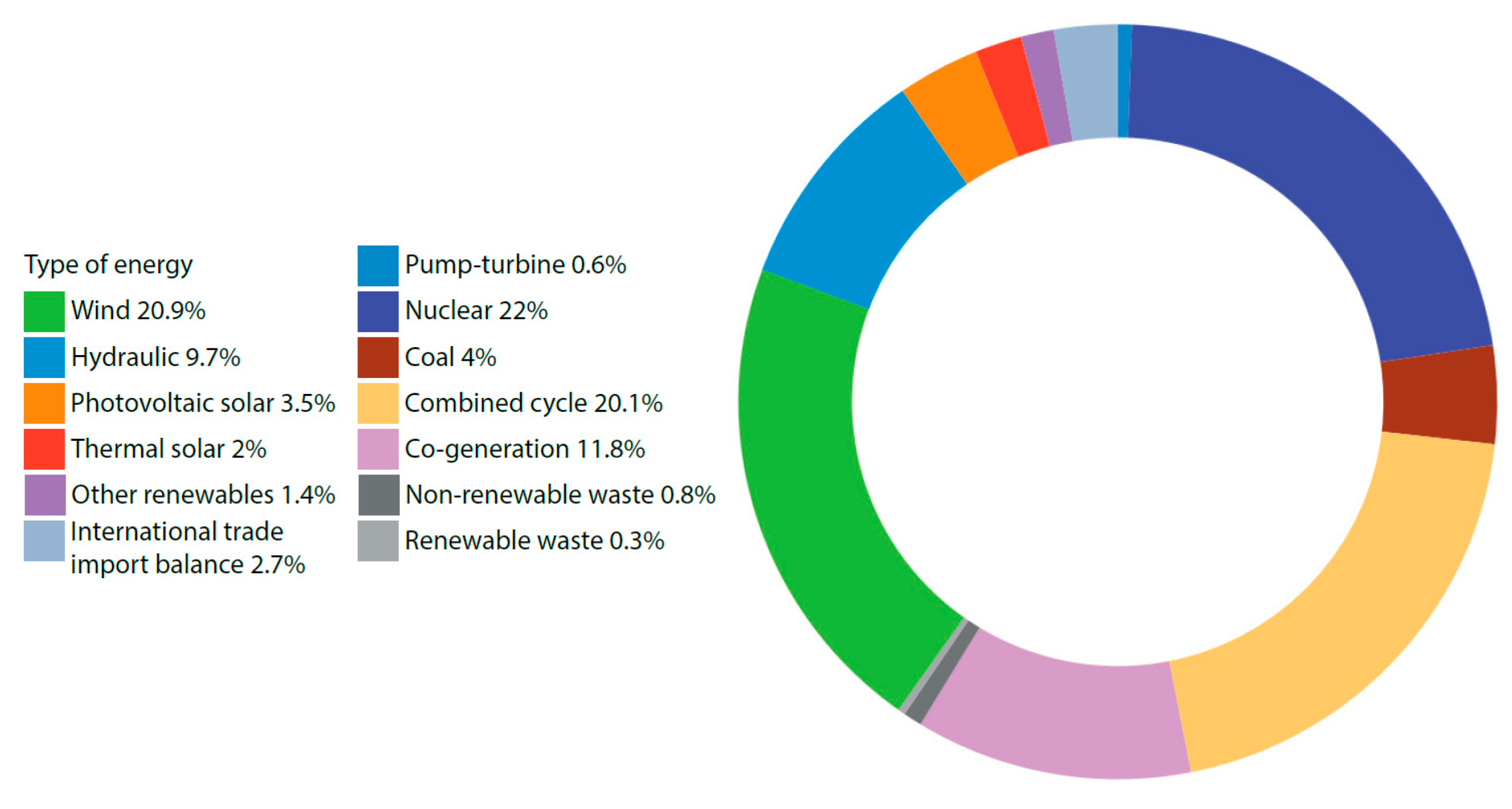
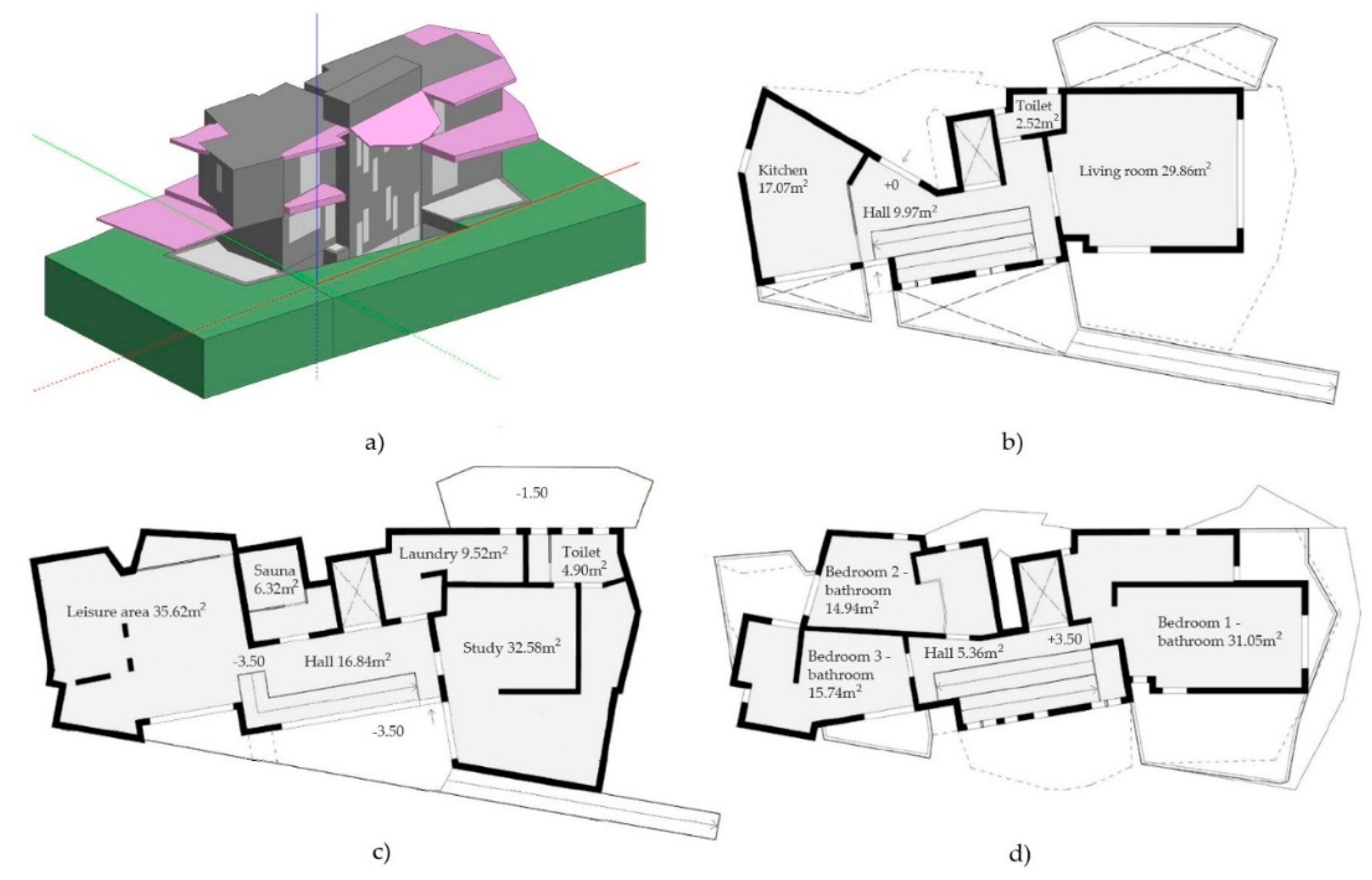
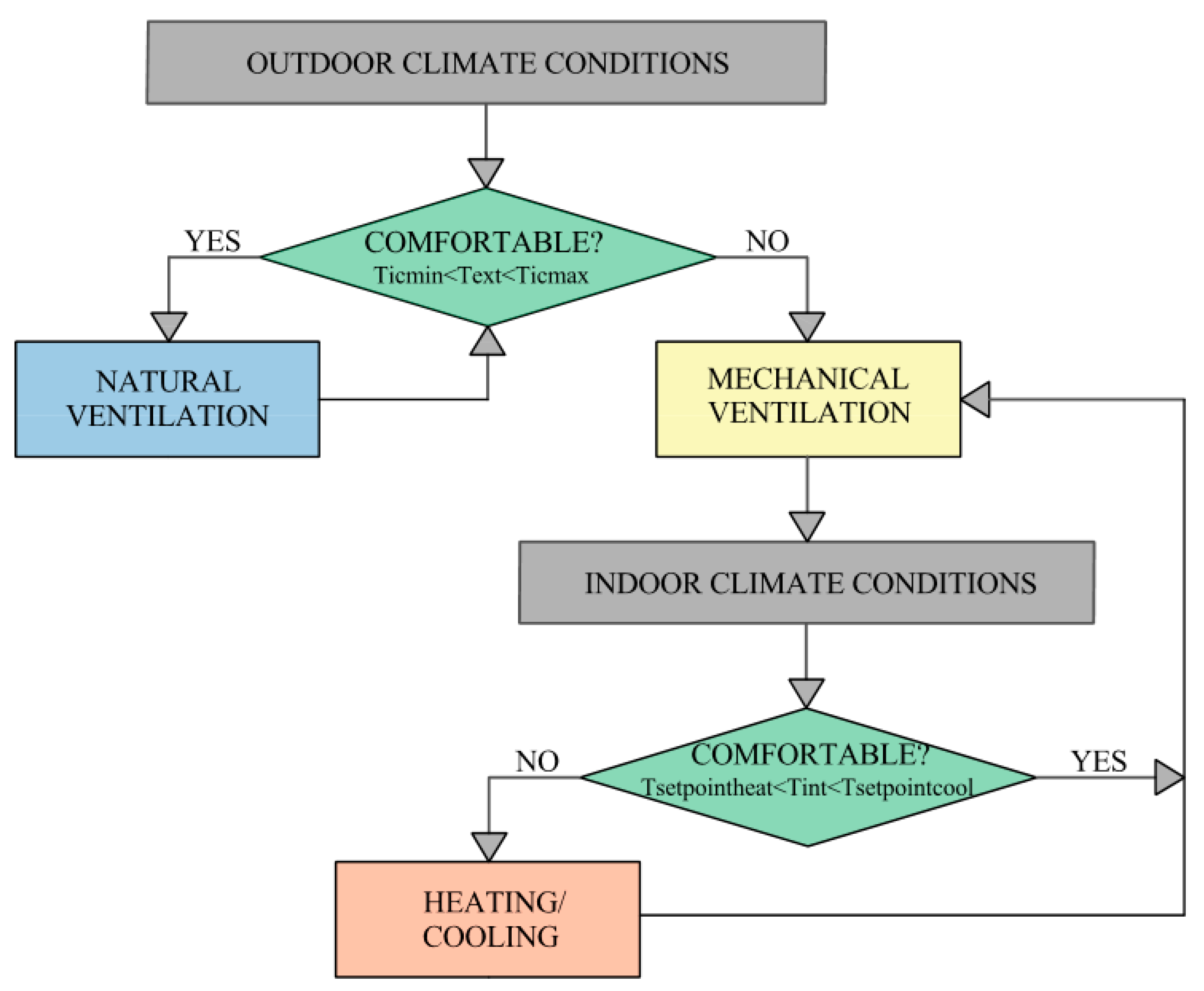

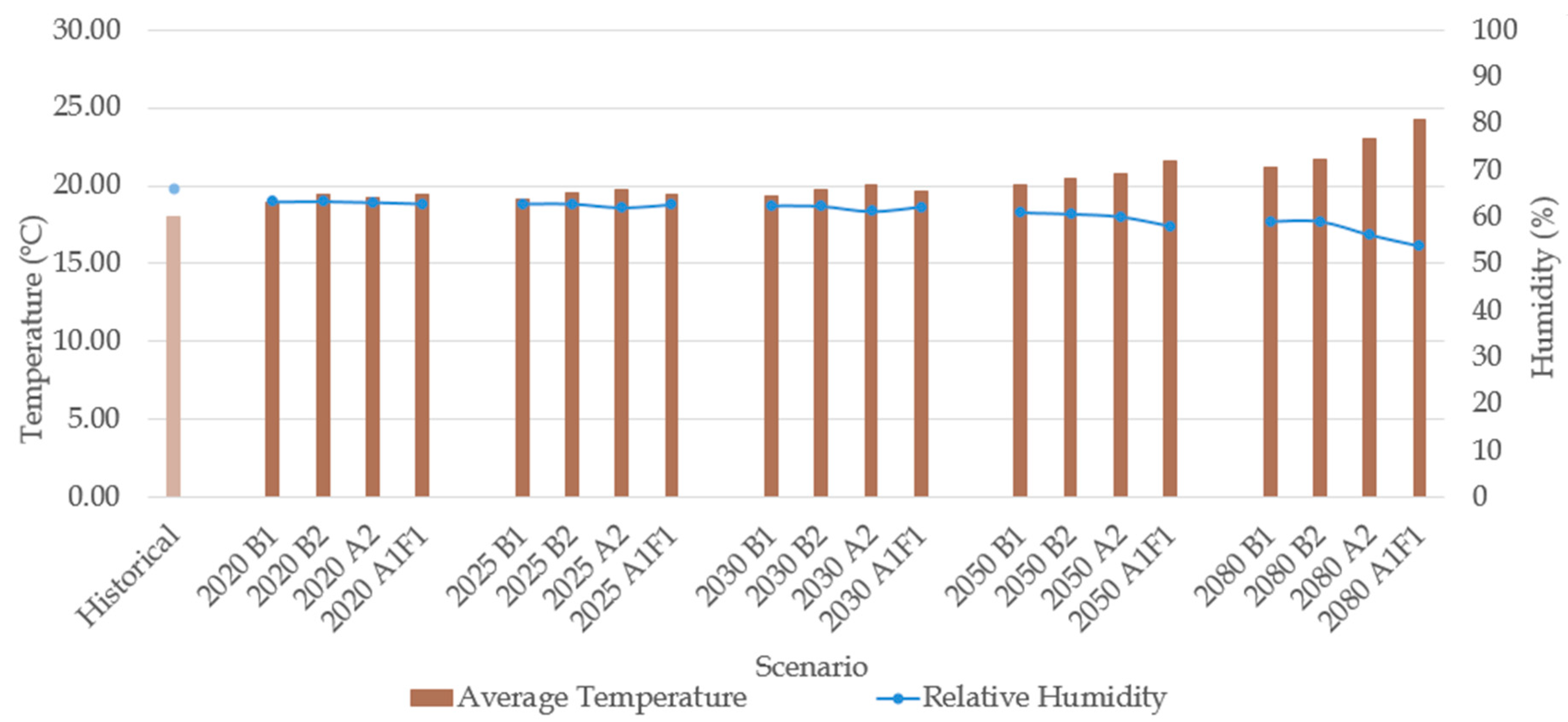
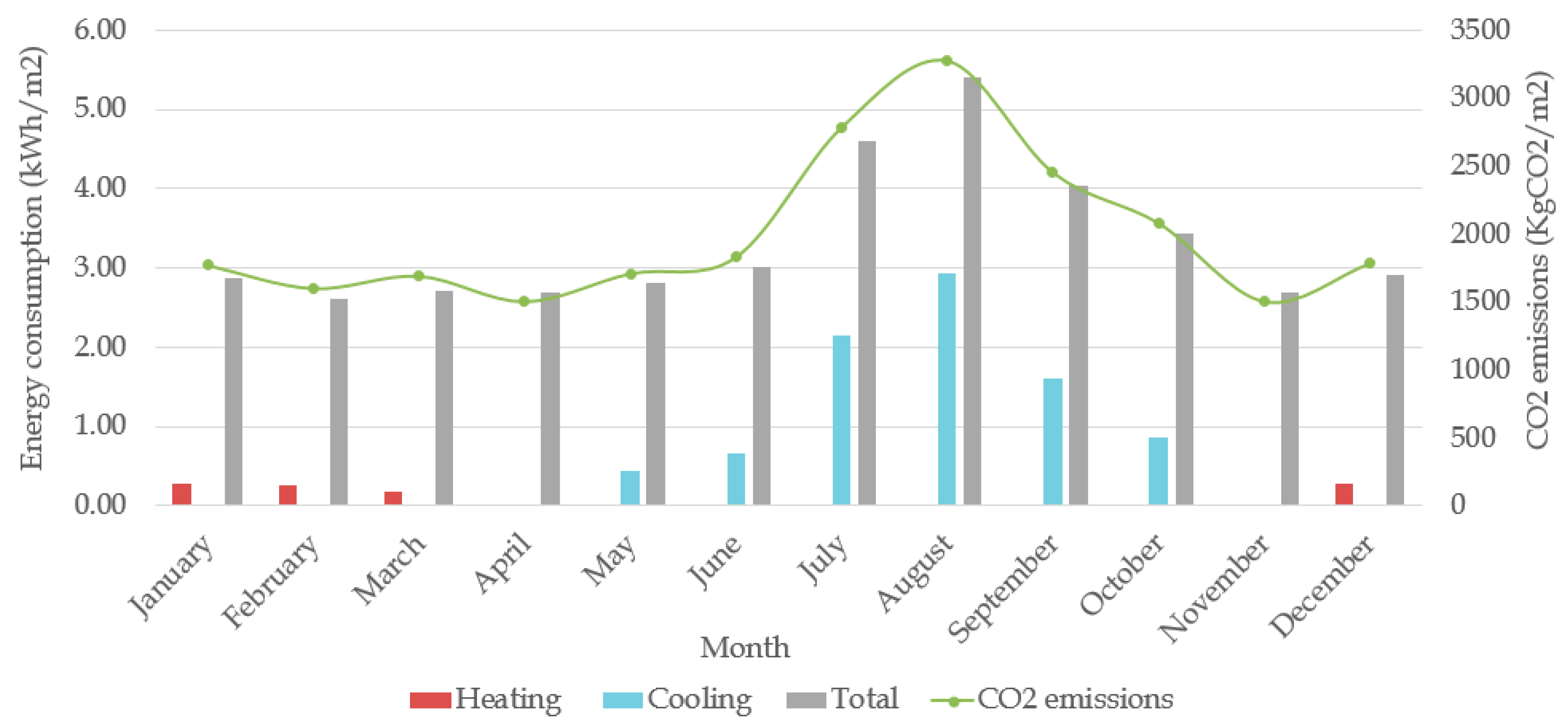
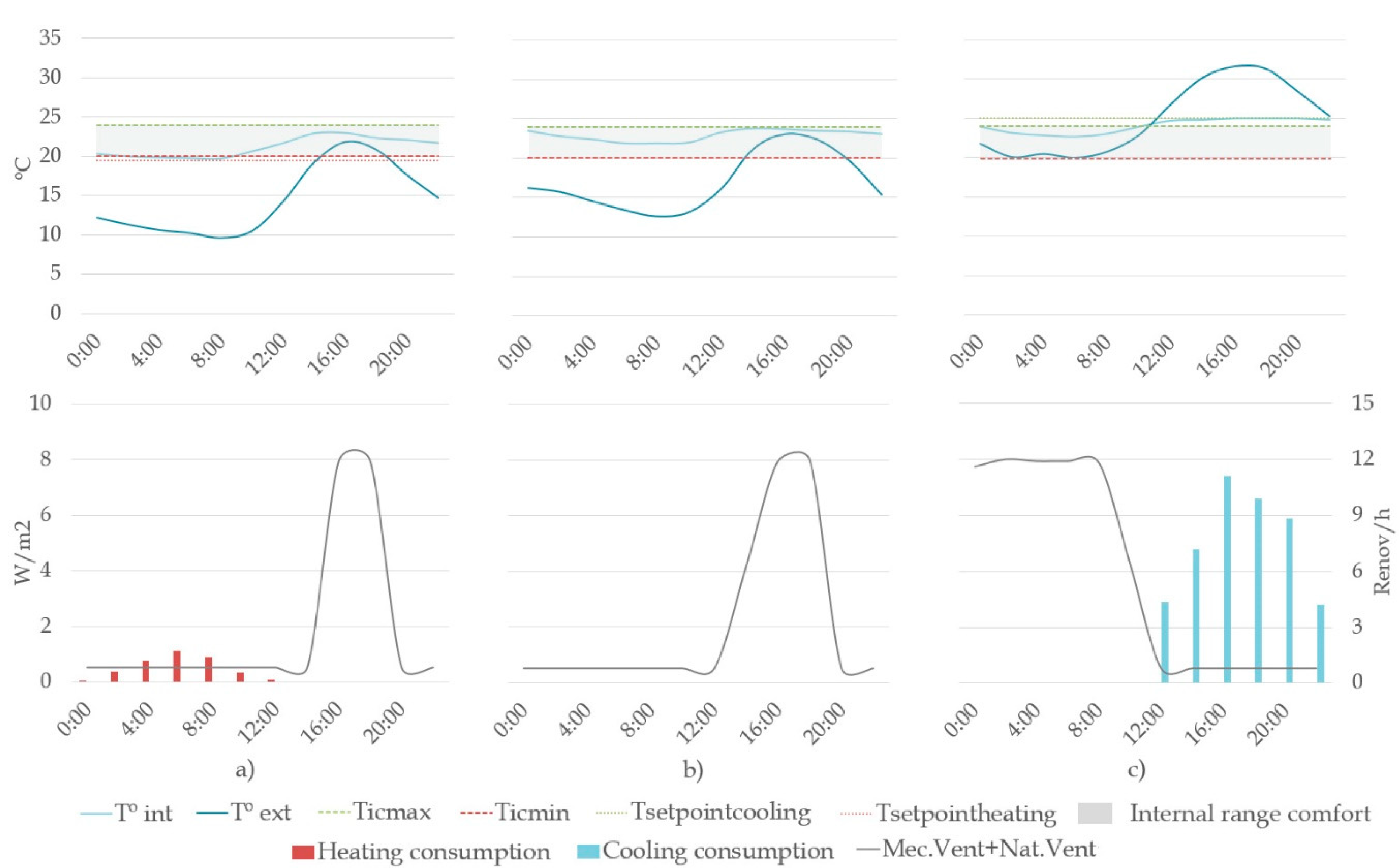
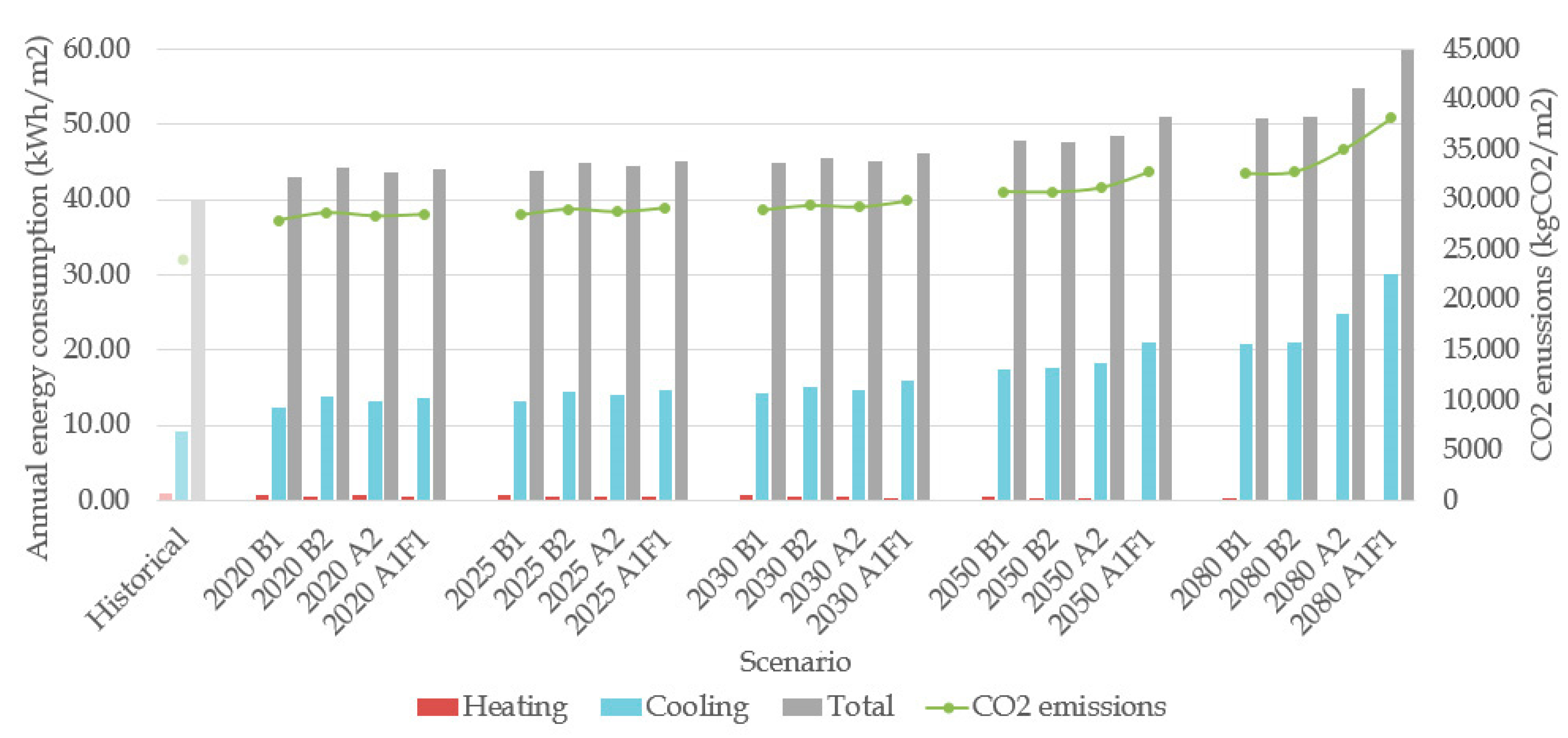
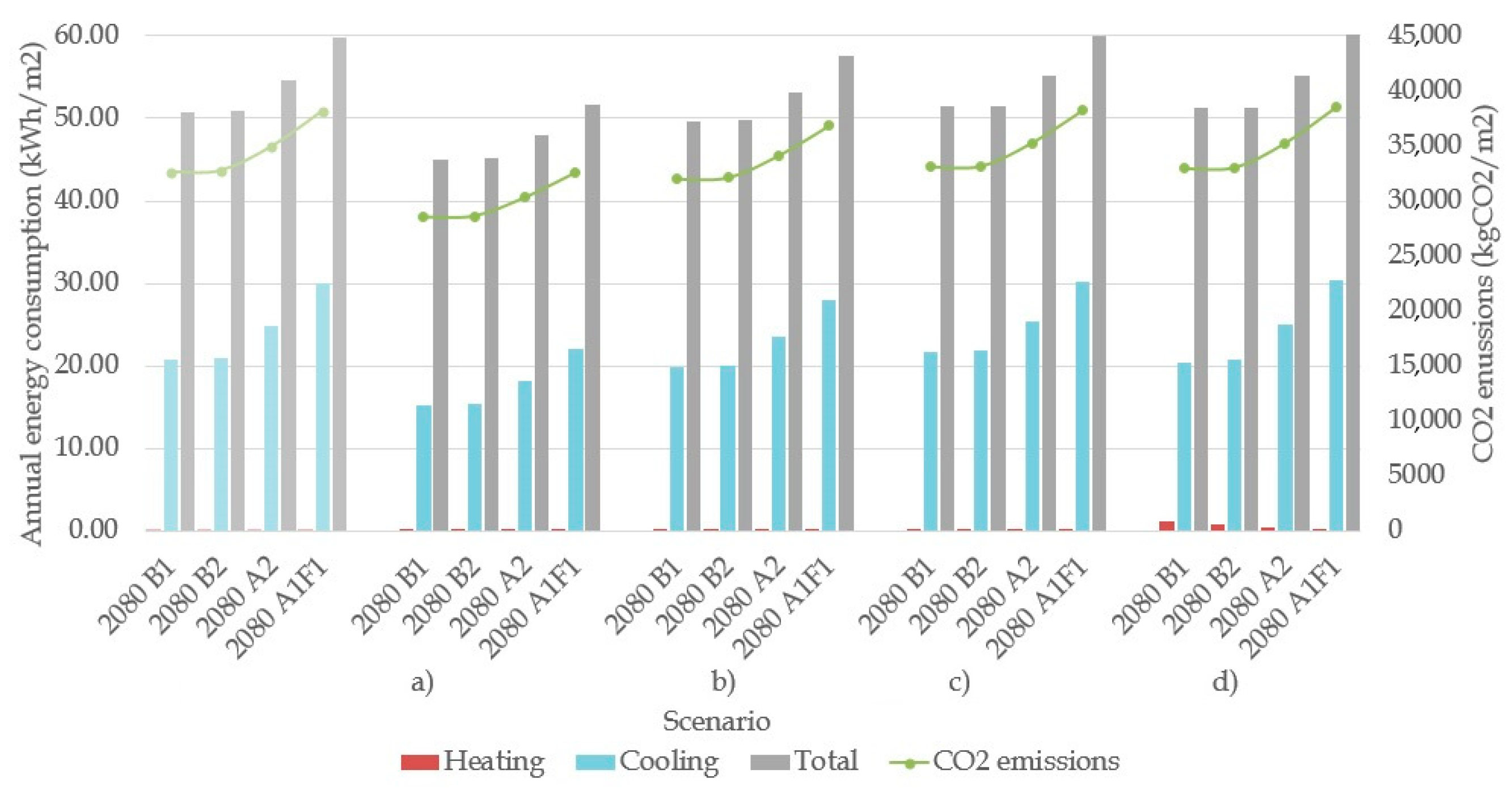
| Scenario | Average Temperature (°C) | Relative Humidity (%) |
|---|---|---|
| Historical | 18.0 | 66.1 |
| Historical Scenario | Energy Consumption per Year kWh/m2 | Conversion Factor * | Primary Energy Demand kWh/m2 | CO2 Emissions kgCO2/m2 |
|---|---|---|---|---|
| Heating | 1 | 1.95 | 1.95 | |
| Domestic hot water | 3.8 | 1.95 | 7.41 | |
| Lighting | 6.7 | 1.95 | 13.06 | |
| Cooling | 9.1 | 1.95 | 17.74 | |
| Appliances and others | 19.3 | 1.95 | 37.63 | |
| Total | 39.9 | 77.79 | 24,140 |
Publisher’s Note: MDPI stays neutral with regard to jurisdictional claims in published maps and institutional affiliations. |
© 2020 by the authors. Licensee MDPI, Basel, Switzerland. This article is an open access article distributed under the terms and conditions of the Creative Commons Attribution (CC BY) license (http://creativecommons.org/licenses/by/4.0/).
Share and Cite
Videras Rodríguez, M.; Sánchez Cordero, A.; Gómez Melgar, S.; Andújar Márquez, J.M. Impact of Global Warming in Subtropical Climate Buildings: Future Trends and Mitigation Strategies. Energies 2020, 13, 6188. https://doi.org/10.3390/en13236188
Videras Rodríguez M, Sánchez Cordero A, Gómez Melgar S, Andújar Márquez JM. Impact of Global Warming in Subtropical Climate Buildings: Future Trends and Mitigation Strategies. Energies. 2020; 13(23):6188. https://doi.org/10.3390/en13236188
Chicago/Turabian StyleVideras Rodríguez, Marta, Antonio Sánchez Cordero, Sergio Gómez Melgar, and José Manuel Andújar Márquez. 2020. "Impact of Global Warming in Subtropical Climate Buildings: Future Trends and Mitigation Strategies" Energies 13, no. 23: 6188. https://doi.org/10.3390/en13236188
APA StyleVideras Rodríguez, M., Sánchez Cordero, A., Gómez Melgar, S., & Andújar Márquez, J. M. (2020). Impact of Global Warming in Subtropical Climate Buildings: Future Trends and Mitigation Strategies. Energies, 13(23), 6188. https://doi.org/10.3390/en13236188






